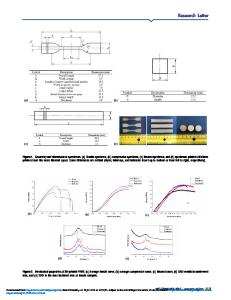Proton Conducting Electrolyte Membranes based on Tungsten Oxide and Sulfonated Polyether Ether Ketone Hybrid Composites
- PDF / 42,693 Bytes
- 6 Pages / 596 x 842 pts (A4) Page_size
- 62 Downloads / 278 Views
0885-A09-12.1
Proton Conducting Electrolyte Membranes based on Tungsten Oxide and Sulfonated Polyether Ether Ketone Hybrid Composites Barbara Mecheri1,2 , Alessandra D’Epifanio 1 , M. Luisa Di Vona 1 , Enrico Traversa1, Silvia Licoccia 1 , and Masaru Miyayama 2 1 Department of Chemical Science and Technology, University of Rome “Tor Vergata”, Via della Ricerca Scientifica 1, 00133 Roma, Italy 2 Research Center for Advanced Science and Technology, The University of Tokyo, 4-6-1 Komaba, Meguro-ku, Tokyo 153-8904, Japan
ABSTRACT Composite membranes, prepared by mixing sulfonated polyether ether ketone (SPEEK) and WO 3 ⋅2H2 O in dimethylacetamide, were characterized by Thermogravimetry, Electrochemical Impedance Spectroscopy and Water Uptake measurements to evaluate their possible performance as proton exchange membranes (PEM). The body of results indicated the existence of a coordinative interaction between the water molecules of tungsten oxide and the sulfonic acid (-SO3 H) groups of SPEEK. Moreover, EIS data demonstrated that the proton conductivity of the composite membranes is higher than both that of pure SPEEK and pure tungsten oxide, suggesting the presence of ion-rich regions where the proton transfer is favored. The SO3 H - H2 O interaction not only lead to enhancement of the proton conductivity of the membranes but also to improvement of their heat resistance as well as to decrease their water solubility.
INTRODUCTION Proton conducting electrolyte membranes (PEM) are receiving increasing attention due to their possible applications as power sources for vehicles, laptop computers and cellular phones [1]. In the development of PEMs, aromatic polymers containing ether links have been widely investigated; among them poly ether ether ketone (PEEK) shows good thermal oxidation resistance and high proton conductivity when sulfonated. However, the sulfonation process leads to undesirable swelling of the membrane and, therefore, to the decrease of its mechanical strength [2]. A possible mean to overcome this problem is the introduction of an inorganic filler into the polymeric membrane [3;4]. In this work, our strategy to improve both proton conductivity and mechanical properties of sulfonated PEEK (SPEEK) membranes consisted in the dispersion of an inorganic proton conducting network in the polymer backbone. Hydrated tungsten oxide (WO3 ⋅2H2O) was selected because of its relatively high proton conductivity up to 150 °C and its layered structure [5]. This ceramic material cannot be easily shaped in the form of a membrane, a problem that might be solved with the formation of a composite system where an organic polymer may supply the needed plastic properties for fuel cells applications. SPEEK/WO3 ⋅2H2 O composite membranes were prepared by mixing proper amounts of SPEEK and hydrated WO3 in N,Ndimethylacetamide (DMA) and the structural and electrochemical performance of the resulting membranes was evaluated.
0882-A09-12.2
EXPERIMENTAL DETAILS Polyether ether ketone (PEEK) was obtained by VICTREX in the form of ext
Data Loading...











